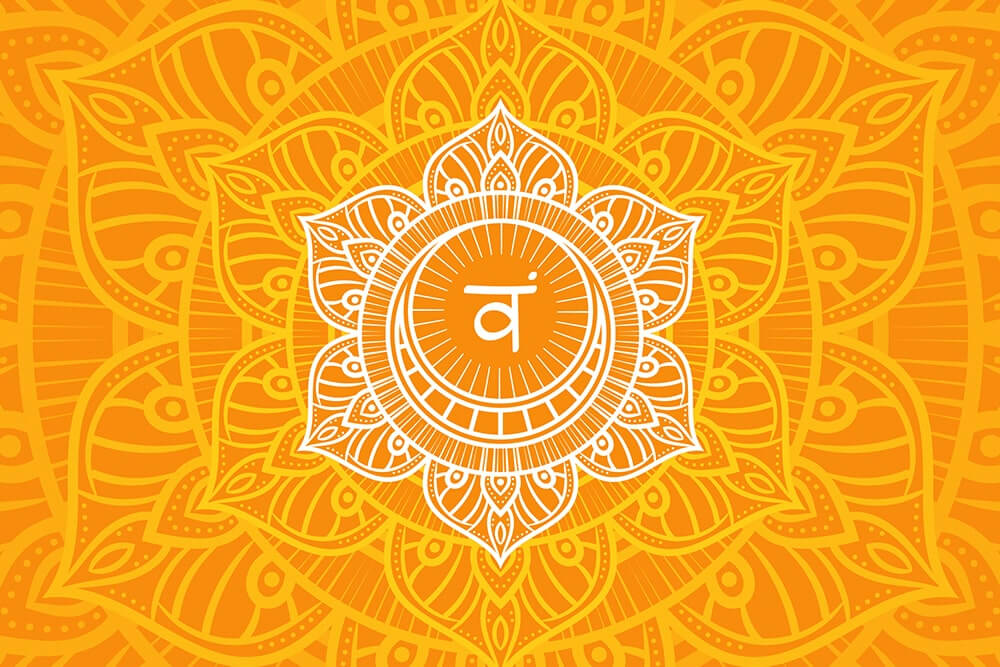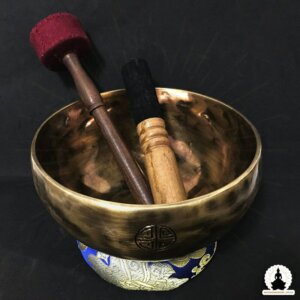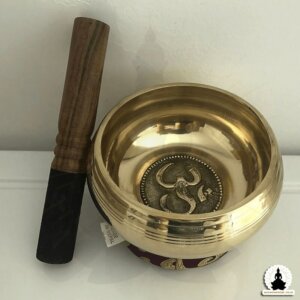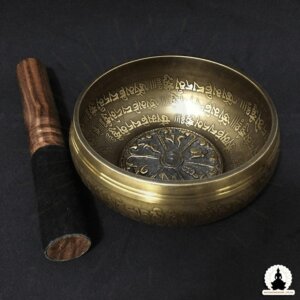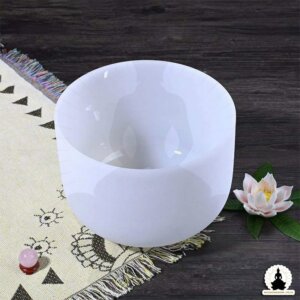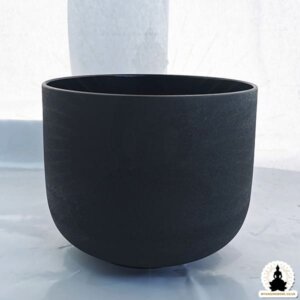Style
The Sacral Chakra Explained: Symbols, Colours, Stones and Balancing Techniques
The chakras are key energy centres in the human body, with deep roots in the Hindu spiritual tradition. They have a significant influence on our physical, mental and spiritual well-being, acting as bridges linking these different aspects of our existence. Among these energy centres, the sacral chakra, also known as Svadhisthana, plays a crucial role.
Svadhisthana, the second chakra in our system, is located just below the navel. Its Sanskrit name translates as “the place of self”, which highlights its essential function as a catalyst for our vital and emotional energy. Closely linked to the element water, the sacral chakra is associated with fluidity, creativity, emotion and sexuality. Understanding and balancing this chakra can greatly enhance our ability to connect with ourselves and others, to experience the world around us and to express our creativity and passion.
Significance of the Sacral Chakra
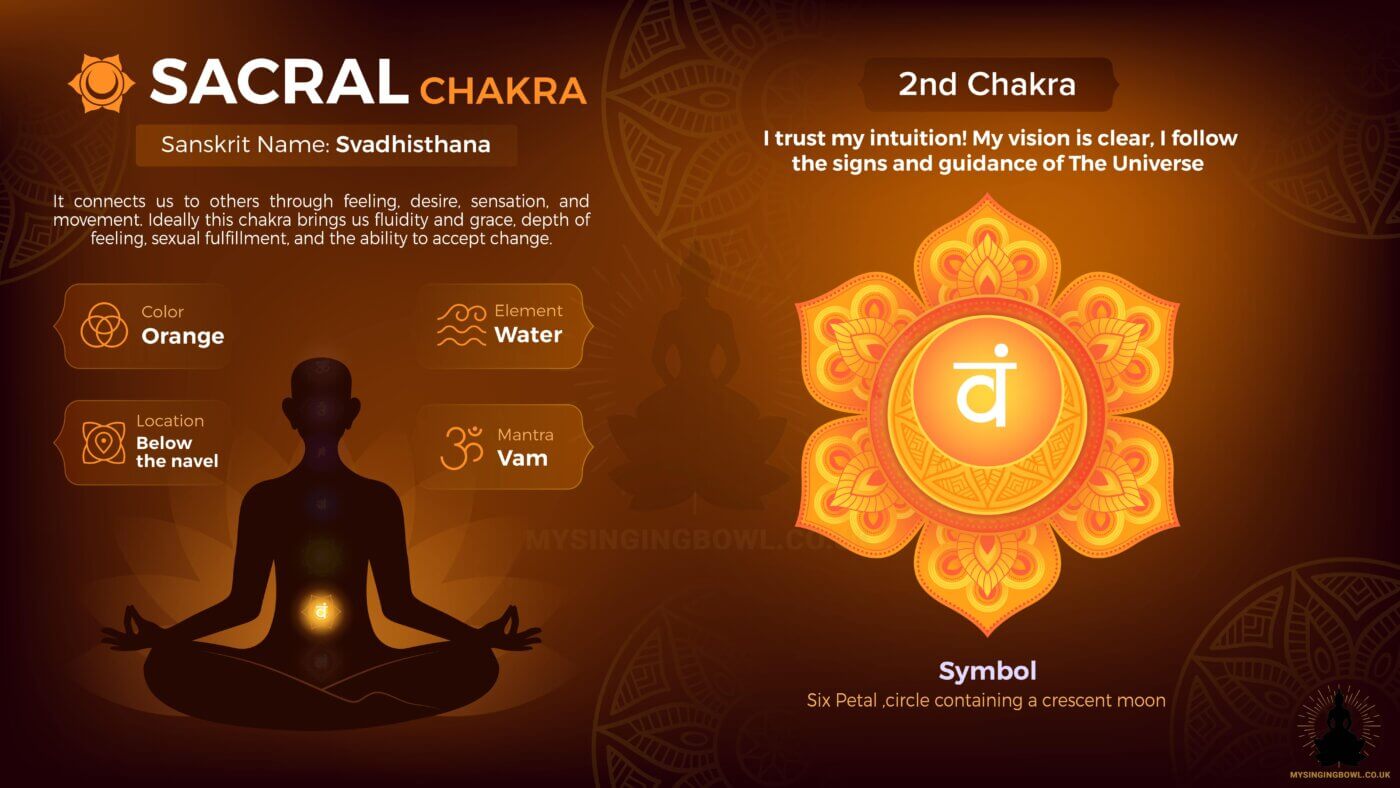
The sacral chakra is the heart of our creative and passionate energy. In the yogic tradition, Svadhisthana is seen as the centre of origin of feelings, emotions and sensory desires. It is the space where we experience the world through our senses, where we feel and express emotions, and where our creativity finds its impetus.
Svadhisthana is associated with our relationship with others and with the world around us. It is the incubator of our creativity, housing our desires and passions. It is closely linked to our ability to feel pleasure, to express our desires and emotions, and to engage in intimate relationships.
A balanced sacral chakra is characterised by a passion for life, abundant creativity, good emotional health and openness to new and varied experiences. It allows us to experience our emotions and sensations fully, without being overwhelmed by them. It helps us to make deep emotional connections with others, to express our creativity in a liberated way and to embrace change as an opportunity for growth.
The History and Origin of the Sacral Chakra
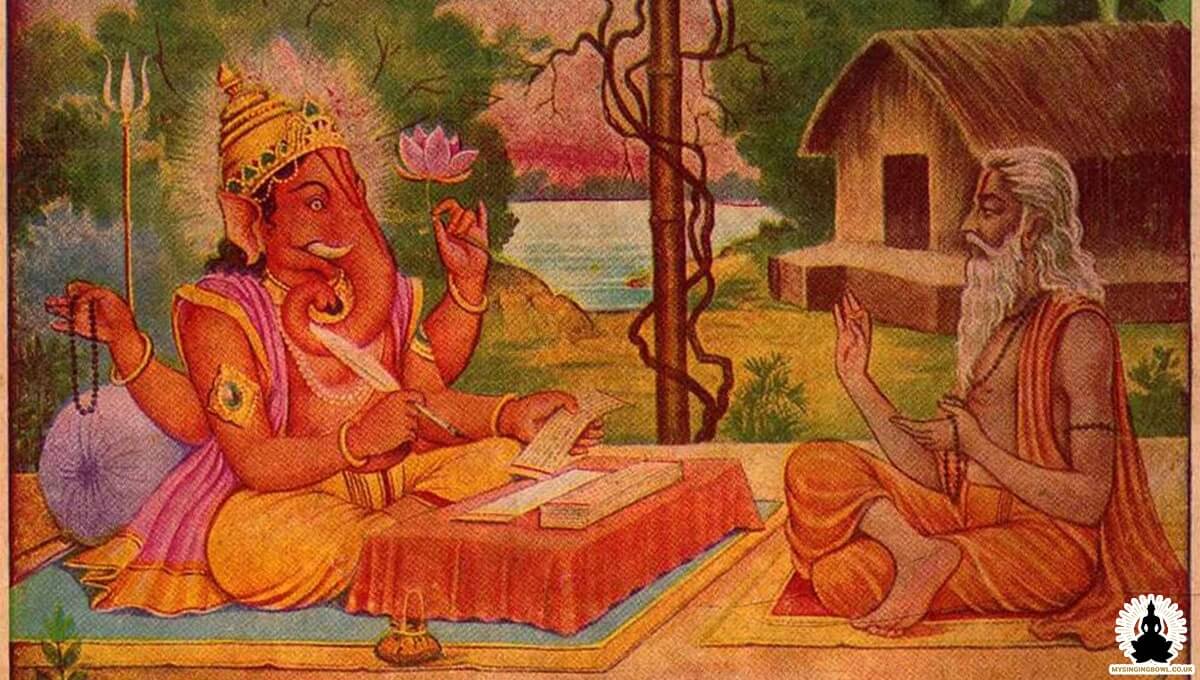
The concept of the chakras has its origins in the Vedas, the ancient Hindu sacred texts. It was there that the seven chakras were first described, depicted as spinning wheels of energy that link our physical body to our spiritual and etheric bodies.
The interpretation and understanding of the sacral chakra have evolved over time. In the Vedic tradition, Svadhisthana is associated with the element water, symbolising flow, flexibility and adaptability. This reflects the changing nature of our emotions and desires, which can fluctuate like currents in a stream. The element of water also evokes the creative aspect of this chakra, as water gives life, nurtures growth and facilitates change. The sacral chakra is also linked to the moon, which governs the tides and emotional cycles. This connection symbolises the ability to experience a wide range of emotions and the fluidity of our creativity.
The Sacral Chakra in Various Spiritual Traditions
In Hinduism, Buddhism and Jainism, the sacral chakra, Svadhisthana, is identified as the centre of creativity, desire and emotional energy. These traditions teach that when this chakra is in balance, it allows free creative expression and respect for desires and emotions, without being overwhelmed by them.
The Reiki tradition also considers the sacral chakra to be a vital centre. It is associated with sexuality, love, passion and creativity. During a Reiki session, specific techniques are used to balance the energy of this chakra, encouraging healthy emotional expression and joie de vivre.
In the Western chakra system and the New Age movement, the sacral chakra is seen as the centre of emotional fulfilment and creativity. It is considered to be the seat of emotions and passion, and its balance is crucial to living a joyful and passionate life. Meditation, yoga, crystal work and other energy healing practices are often used to balance and activate Svadhisthana.
Certain shamanic traditions also respect the importance of the sacral chakra. They see it as a point of connection with the waters of the Earth and the lunar cycles, emphasising its link with the element of water and the emotions.
Location of the Sacral Chakra
The Sacral Chakra is the second chakra in our energy system. It is located in the region of the pelvis, between the navel and the pubis, more precisely at the level of the sacrum, hence its name. This is why it is sometimes called the sacrum chakra.
From an energy point of view, it is located just below the root chakra and is traditionally associated with the element water. Its proximity to the reproductive organs reflects its link with creativity, procreation and emotional expression.
From a health point of view, the sacral chakra is linked to various parts of the body, such as the kidneys, reproductive organs, bladder and circulatory system. When this chakra is out of balance, it can affect these organs and systems, causing various health problems.
In terms of energetic structure, the sacral chakra is the crossing point for three important energy channels or nadis: Ida, Pingala and Sushumna. It plays a crucial role in the circulation of vital energy, or prana, in our body. A well-balanced sacral chakra allows energy to flow smoothly, promoting vitality and general well-being.
The Divinity Associated with the Sacral Chakra
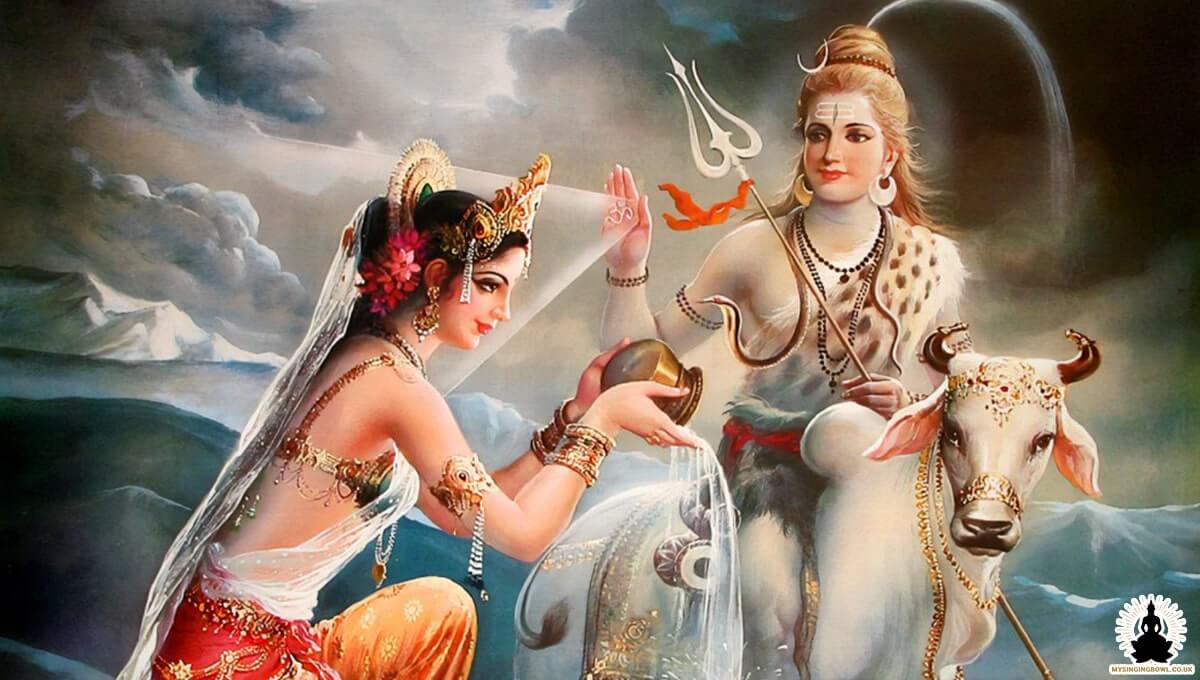
In the yogic system, the sacral chakra or Svadhisthana is traditionally associated with certain specific deities who embody its unique qualities. In this case, the goddesses Parvati and Rakini are often linked to this energy centre.
Parvati is a Hindu goddess, considered to be the wife of Shiva and the mother of Ganesh. She is revered for her devotion to her husband, as well as for her strength and power. Parvati is also associated with the goddess of fertility, love and devotion, all qualities inherent in the sacral chakra. By meditating on Parvati or invoking her energy, we can seek to balance and activate these aspects of Svadhisthana.
Rakini, on the other hand, is a goddess specifically associated with Svadhisthana in certain Tantric texts. She is often described holding a trident and a cup of wine, symbols of the passion and sensory experience that lie at the heart of the sacral chakra. Rakini is also associated with water, the element linked to Svadhisthana, representing movement, fluidity and the ability to adapt to change.
By integrating the teachings and energy of these deities into spiritual practice, practitioners can aim to balance the sacral chakra, encouraging the healthy expression of creativity, passion and emotion.
Symbols of the Sacral Chakra
Like all the chakras, the sacral chakra, or Svadhisthana, is represented by specific symbols that express its unique nature and attributes. These symbols are rich in meaning and can help to understand and balance this chakra.
The six-petalled lotus: In Hindu iconography, Svadhisthana is often depicted as a six-petalled lotus. Each petal corresponds to a specific vibration, symbolised by a sound or mantra. These sounds are Bam, Bham, Mam, Yam, Ram and Lam.
The crescent moon: The sacral chakra is also symbolised by a silver or white crescent moon, representing the element of water associated with Svadhisthana. Water symbolises movement, fluidity and adaptability, important attributes of this second chakra.
The sacred animal: The sacral chakra is also often associated with an animal, the makara, a creature from Hindu mythology which is generally described as a crocodile. The makara symbolises the subconscious and the emotions, reflecting Svadhisthana’s link with the emotional world.
Colours associated with the Sacral Chakra
Colour plays an essential role in the symbolism and balancing of the chakras. For the sacral chakra, or Svadhisthana, the dominant colour is orange. This vibrant colour is strongly linked to creativity, emotion and sexuality, which are all aspects of Svadhisthana.
Orange, as a blend of red (the colour of the root chakra, symbolising survival and instinct) and yellow (the colour of the solar plexus, symbolising personal power and confidence), represents a balance between these two energies. This reflects Svadhisthana’s position as the chakra that balances our basic needs with our personal power.
Orange is also the colour of joy, enthusiasm and creativity. It embodies the vital energy and passion of Svadhisthana, and can help stimulate these qualities when the sacral chakra is blocked or out of balance.
In practice, we can use these colours to help balance the sacral chakra, whether by wearing orange clothes, using orange crystals, visualising the colour orange during meditation, or even eating food in this colour.
Sacral Chakra Stones
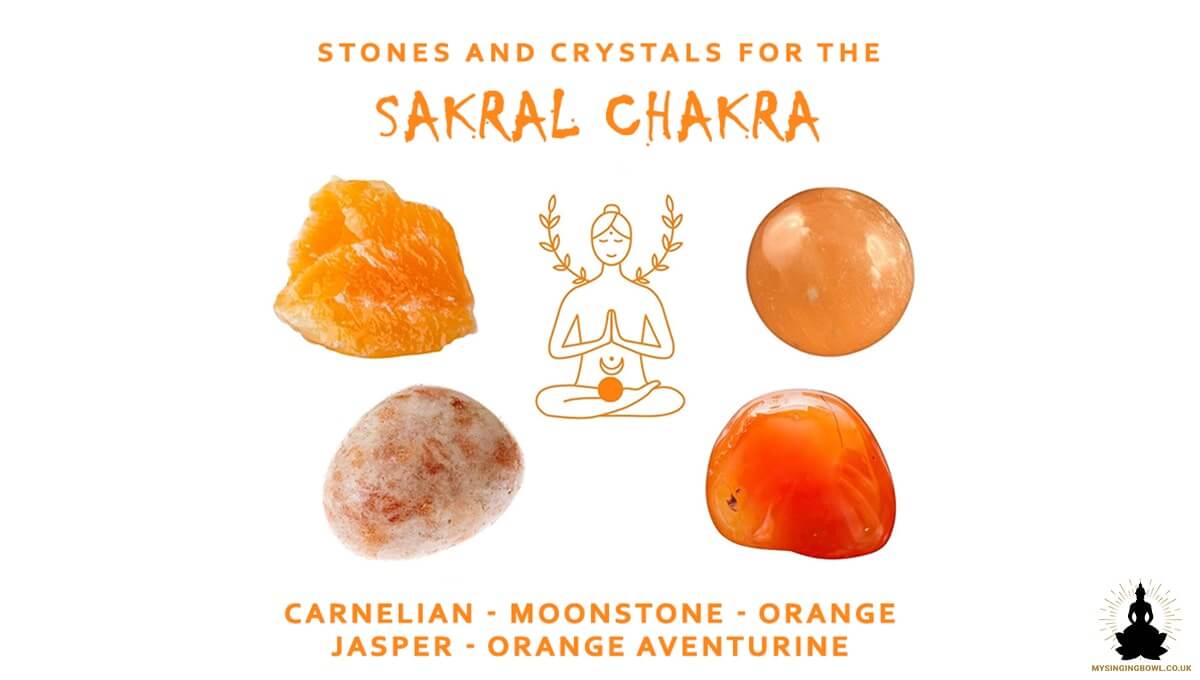
Certain stones are particularly associated with Svadhisthana, including carnelian, moonstone, orange jasper and orange aventurine. These stones are known for their ability to balance the energy of the sacral chakra, promote creativity and encourage positive emotional expression.
Stones can be used in several ways to balance the sacral chakra. They can be worn as jewellery, used in meditation, or placed at the site of the chakra during a reiki or energy healing session.
The choice and care of these stones are important elements in maximising their effectiveness. We recommend choosing stones that resonate with you on a personal level and cleaning them regularly to release the energy they have absorbed.
Sound and the Sacral Chakra
Sound has a major influence on the energies of our body, including our chakras. For the sacral chakra, the associated sound or mantra is “VAM”. Repeating this sound during meditation can help to balance and activate Svadhisthana, stimulating the flow of energy in this area.
The effectiveness of this technique is based on vibratory resonance. The “VAM” sound resonates at the same frequency as the sacral chakra, facilitating the circulation of energy and helping to dissipate blockages.
As well as reciting or chanting the mantra, listening to specific music or sounds can also have a balancing effect on Svadhisthana. This can include music with frequencies corresponding to that of the sacral chakra, or sounds of nature such as flowing water, linked to the element of water associated with this chakra.
Tibetan bowls and crystal bowls are other sound tools commonly used to balance the chakras. Bowls produce harmonic and vibratory sounds that can help realign unbalanced energies. For the sacral chakra, medium-sized bowls with a note corresponding to the Svadhisthana frequency are often preferred.
Sound practices are an integral part of chakra balancing, and can be combined with other techniques, such as meditation, yoga, and the use of stones or colours, for a more complete and integral effect. It is important to note that regular practice is key to achieving lasting results.
Identifying Sacral Chakra Imbalances
Recognising the signs of an unbalanced sacral chakra is the first step towards regaining harmony and balance. When Svadhisthana is blocked or overactive, it can manifest itself in a number of emotional, physical and mental ways.
On an emotional level, an unbalanced sacral chakra can lead to problems related to creativity, sexuality and emotion. This can manifest as low self-esteem, reduced libido, a tendency to feel guilty or ashamed, a lack of passion and motivation, or problems with expressing emotions.
On a physical level, Svadhisthana governs the pelvic area, including the reproductive organs and kidneys. Consequently, an imbalance can manifest itself as problems in these areas, such as lower back pain, kidney or bladder problems, fertility problems or menstrual disorders.
On a mental level, an unbalanced sacral chakra can manifest itself in compulsive or addictive behaviour, a lack of creativity, a fear of change or resistance to new experiences.
These signs are indicators that it may be time to focus on balancing your sacral chakra. Of course, they can also be linked to other factors and health problems. So it’s important to always consult a healthcare professional or spiritual advisor if you experience persistent or severe symptoms.
Sacral Chakra Balancing Techniques
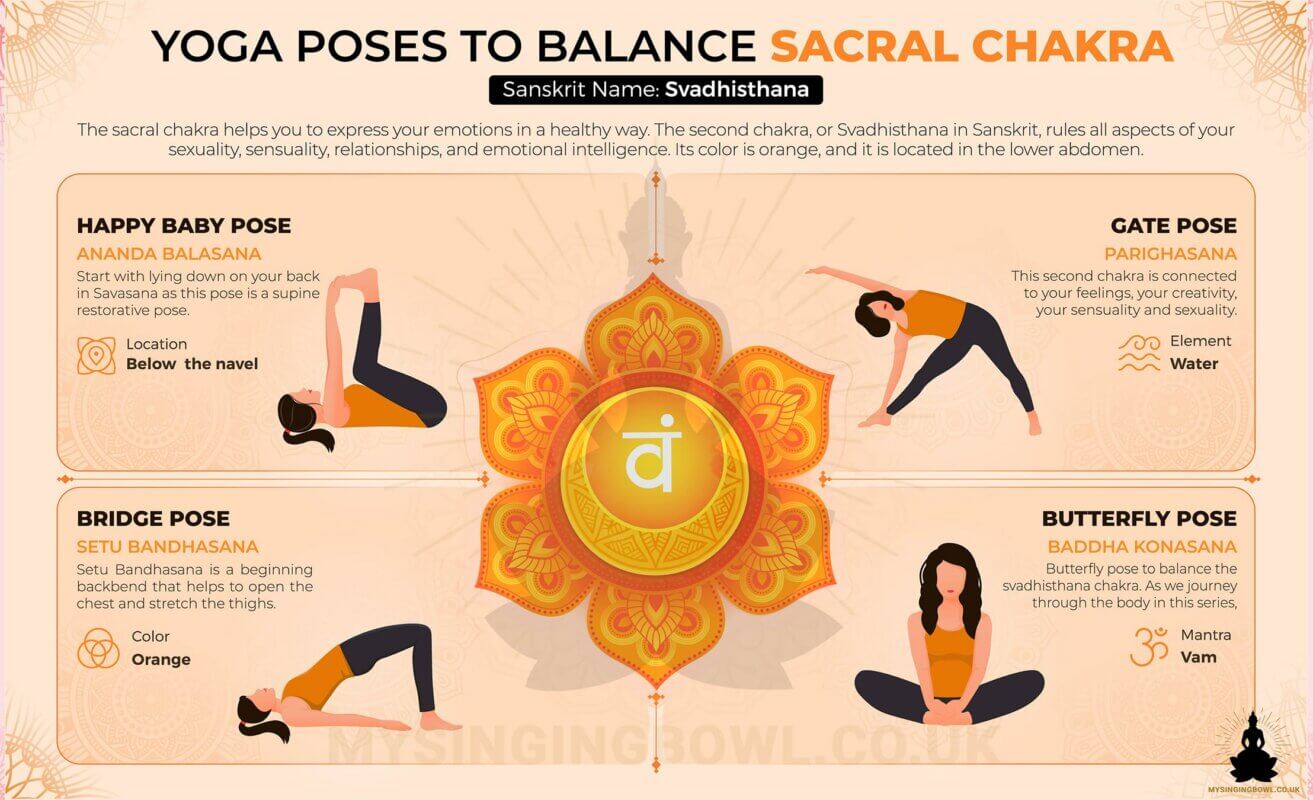
Balancing the sacral chakra is essential for maintaining a balanced and harmonious life. There are many techniques that can help restore balance to this area of energy, including the following.
Meditation is an effective technique for balancing the chakras. By concentrating on your sacral chakra during meditation, visualising its orange colour and repeating the mantra “VAM”, you can help to activate and rebalance Svadhisthana.
Breathing techniques, or pranayama, can also be beneficial. Deep, conscious breathing can help release tension and encourage the flow of energy throughout the body, including the sacral chakra.
Yoga is another powerful technique for balancing the chakras. Specific postures, such as the Goddess Pose or the Pincer Pose, can help stimulate and balance the sacral chakra.
A balanced diet can also help to support the sacral chakra. Foods rich in water, such as fresh fruit and vegetables, as well as orange foods, can help to balance Svadhisthana.
The use of specific stones and crystals, such as carnelian and moonstone, can also help to balance the sacral chakra.
Finally, as mentioned above, the use of sound, whether through mantras, specific music or Tibetan and crystal bowls, can also have a positive impact on the sacral chakra.
Remember, regular practice is essential to maintain balance. It’s important to incorporate these techniques into your daily routine to see lasting results.
Conclusion
The sacral chakra, or Svadhisthana, plays a vital role in our ability to feel and express our emotions, creativity and sensuality. A balanced sacral chakra contributes to a balanced, fulfilling and creative life. We hope this article has given you the tools you need to better understand and balance your own sacral chakra. With these techniques and knowledge, you can now embark on your own journey towards balance and spiritual well-being.

